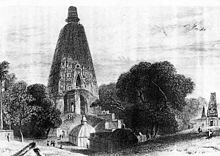This is an old revision of this page, as edited by Nehrams2020 (talk | contribs) at 23:09, 2 July 2007 (Repairing link to disambiguation page - You can help!). The present address (URL) is a permanent link to this revision, which may differ significantly from the current revision.
Revision as of 23:09, 2 July 2007 by Nehrams2020 (talk | contribs) (Repairing link to disambiguation page - You can help!)(diff) ← Previous revision | Latest revision (diff) | Newer revision → (diff)| Part of a series on |
| Buddhism |
|---|
 |
| History |
| Buddhist texts |
| Practices |
| Nirvāṇa |
| Traditions |
| Buddhism by country |
The Maha Bodhi Society is a South Asian Buddhist society founded by the Sri Lankan Buddhist leader Anagarika Dharmapala. The organization's self-stated initial efforts were for the purpose of resuscitation Buddhism in India and of restoring the ancient Buddhist shrines at Bodh Gaya, Sarnath and Kushinara.
Origins
In 1891 while on pilgramage to the recently restored Mahabodhi Temple at Bodh Gaya, the location where Siddhartha Gautama - the Buddha - attained enlightenment, Anagarika Dharmapala had experienced a shock to find the temple in the hands of a Saivite priest, the Buddha image transformed into a Hindu icon and Buddhists barred from worship as a result of which he began he began an agitation movement. The Buddhist renaissance inaugurated by Anagarika Dharmapala through his Mahabodhi Movement has also been described as "conservative" for it held the Muslim Rule in India responsible for the decay of Buddhism in India, in the then current mood of Hindu-Buddhist brotherhood.
The Mahabodhi society at Colombo was founded in 1891 but it offices were soon moved to Calcutta the following year in 1892. One of it's primary aims being the restoration of the Mahabodhi Temple at Bodh Gaya, the chief of the four ancient Holy sites to Buddhist control. To accomplish this Dharmapala initiated a lawsuit against the Brahmin priests who had held control of the site for centuries. After a protracted struggle this was successful with the partial restoration of the site to the management of the Maha Bodhi Society in 1949.
The Mahabodhi Temple
Main article: Mahabodhi TempleAfter the defeat of the Palas by the Hindu Sena dynasty, Buddhism's position again began to erode and was soon followed by the conquest of Magadha by General Ikhtiar Uddin Muhammad Bin Bakhtiyar Khilji. During this period, the Mahabodhi Temple fell into disrepair and was largely abandoned. During the 16th century, a Hindu monastery was established near Bodh Gaya. Over the following centuries, the monastery's abbot or mahant became the area's primary landholder and claimed ownership of the Mahabodhi Temple grounds.

In the 1880s, the-then British government of India began to restore Mahabodhi Temple under the direction of Sir Alexander Cunningham. A short time later, in 1891, Anagarika Dharmapala started a campaign to return control of the temple to Buddhists, over the objections of the mahant. The campaign was partially successful in 1949, when control passed from the Hindu mahant to the state government of Bihar, which established a temple management committee. The committee has nine members, a majority of whom, including the chairman, must by law be Hindus. Mahabodhi's first head monk under the management committee was Anagarika Munindra, a Bengali man who had been an active member of the Maha Bodhi Society.
Sarnath
Main article: SarnathIn 1931 the Mulaghandakuti Vihara was erected at Sarnath.
Kushinara
Main article: KushinagarThe site of the Buddha's parinibbana (physical death) at Kushinagar has once again become a major attraction for Burmese Buddhists, as it was for many centuries previously.
Maha Bodhi Society branches have been established in several countries, most significantly in India and Sri Lanka. A United States branch was founded by Dr. Paul Carus.
The Maha Bodhi Society has a robust tradition of publications, spanning from Pali translations into modern Indian vernacular languages (such as Hindi) to scholarly texts and new editions of Pali works typeset in Devanagari to appeal to a Hindi-educated Indian audience. They have also published books and pamphlets in local/regional languages and dialects, sometimes in partnership with other presses.
As of 2003, the Maha Bodhi Society of India's general secretary is Dombagoda Rewatha Thero. On September 27, 2004, B. K. Modi was elected president; he was previously vice-president. Modi was, until recently, an office-holder in the Vishwa Hindu Parishad.
There is also a Maha Bodhi Society of Bangalore, founded by Acharya Buddharakkhita in 1956, which is not a part of or tied to the Maha Bodhi Society of India or Sri Lanka.
References
- Mahabodhi Society
- Sean O'Reilly, James O'Reilly, Pilgrimage: Adventures of the Spirit, Travelers' Tales, 2000,ISBN 1885211562 pg 81-82
- A Close View of Encounter between British Burma and British Bengal
- ^ Arnold Wright, Twentieth Century Impressions of Ceylon: its history, people, commerce, industries, and resources, "Angarika Dharmapala", Asian Educational Services, 1999, ISBN 812061335X pg.119
- ^ C. J. Bleeker, G. Widengren, Historia Religionum, Volume 2 Religions of the Present: Handbook for the History of Religions, Brill Academic Publishers, 1971, ISBN 9004025987 pg. 453
- The Maha-Bodhi By Maha Bodhi Society, Calcutta (page 205).
See also
External Links
This Buddhism-related article is a stub. You can help Misplaced Pages by expanding it. |